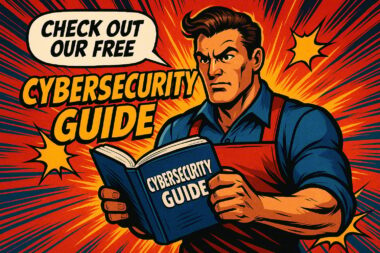We’re Only Open From 9 to 5
This is a myth that some business owners believe–that they only need their IT network monitored for security when their staff is at work. Maybe this is because, in the past, brick-and-mortar companies in SE Texas like law firms, banks, construction companies, and manufacturing businesses relied on alarm systems or security guards to protect their facilities during working hours.
Because these companies and others now conduct much of their business online, they need more than physical security. Working online is like having your facility next to a busy interstate highway where it’s exposed to a multitude of people driving by. Your organization is exposed to anyone on the Internet 24 x7. This is why it’s necessary to implement around-the-clock IT monitoring to detect and block any intrusions from internet traffic.
Who’s Watching Your Network When You’re Not There?
The reality of cyber attacks is that most of the malicious and damaging activity happens after hours when hackers know no one is looking. Would you know if your technology was hit with a virus in the middle of the night? You would if your technology service provider monitored your IT network 24 x 7. They could detect it, isolate it and delete it before you showed up for work in the morning – ensuring that your technology would be there for you.
Most small and midsized businesses (SMBs) in SE Texas have limited or no IT staff. Even when they do, are they there in the middle of the night? Plus, most in-house techs don’t have the most up-to-date knowledge about the thousands of cyber threats that are surfacing every day.
They usually have few cybersecurity skills and can get overwhelmed when they have to investigate the multitude of threats in addition to handling their daily IT responsibilities. Plus, they often don’t always know how to find and contain ransomware. As a result, many SMBs aren’t monitoring their technology 24/7, 365 days a year for malware that can shut them down.
But You Say – We Have a NOC – Isn’t This Enough?
Some businesses have a network operations center (NOC) that is staffed by IT personnel. These people handle end-user support calls, manage their data backups, ensure network connectivity, apply patches and handle other maintenance activities.
However, NOC staff usually doesn’t focus on cybersecurity.
What’s needed is a Security Operations Center (SOC).
What Is a SOC?
A SOC focuses specifically on detecting and responding to security threats. It combines technology, people, processes and knowledge. IT security experts validate potential incidents, assemble the appropriate context, investigate as much as is feasible about the scope and severity given the information and tools available, provide actionable advice and context about the threat, and can remotely stop the attack.
It uses intrusion detection/prevention tools, and threat-intelligence feeds. Personnel in a Security Operations Center are security analysts who:
- Monitor the SOC dashboard 24/7,
- Triage and investigate incoming alerts,
- Use repeatable forensics analysis and incident response processes, and
- Identify security incidents that could affect the business.
The frequency of today’s cyber attacks and data breaches requires that you bolster your defenses. And, many businesses are recognizing the need for a security operations center (SOC) that combines the right people, processes, and technology to help them effectively identify and respond to growing threats.
Is a 24/7 SOC Expensive To Build and Maintain?
This is the problem. For a small or mid-sized business, the costs of building out your own SOC can be overwhelming. It involves building an in-house staff of security experts with eight to 12 people with cybersecurity skills. And they must be there on a 24/7 basis in order to provide the necessary round-the-clock SOC services.
For small and mid-sized networks, an in-house SOC just isn’t feasible due to the costs involved. The typical SOC team is composed of security analysts who act as first responders. They triage the security alerts to security engineers who apply threat intelligence, identify false-positives, and determine what the high priority incidents are. Then you’ll need a security manager to oversee the SOC team. This is cost-prohibitive for most SMBs.
A total cost of ownership (TCO) study conducted by Frost & Sullivan concluded that it costs up to 8.8 times more over a three-year period to build a 24/7 SOC in-house versus subscribing to a SOC-as-a-Service. This is because it’s so difficult to find and retain the necessary security talent required to operate and manage an in-house SOC.
What’s The Solution? SOC-as-a-Service
Thankfully you can sign up for SOC-as-a-Service (SOCaaS). It delivers 24/7 monitoring with the people, processes, and technology you need to manage and maintain your security posture. It reduces business risks for companies with limited budgets.
SOC-as-a-Service lets your IT staff focus on solving business-related issues, while outsourcing threat detection and incident response to cybersecurity experts. It’s an affordable alternative for many organizations in SE Texas—It doesn’t require investment in additional hardware, software, or staff.
How Does SOC-as-a-Service Work?
SOC-as-a-Service resides behind your firewall. It delivers 24/7 threat monitoring, advanced analytics, threat intelligence, and human expertise in a combined incident investigation and response. It will scan all of your network traffic using Artificial Intelligence (AI).
SOC-as-a-Service provides cybersecurity monitoring for all your critical devices. It uses advanced analytics and correlation to detect threats and generate automated notifications 24 hours a day, 365 days a year.
Then real-life security analysts review your security data every day for human oversight and compliance.
SOC experts validate potential incidents, assemble the appropriate context, investigate as much as is feasible about the scope and severity given the information and tools available, provide actionable advice and context about the threat, and can remotely stop the attack.
Knowing about all of your critical devices, what they do, and how they’re configured is essential for accurate correlation and analysis. This information is used to automatically track configuration changes.
You’ll be alerted of validated security events with incident triage performed by IT professionals. They’ll look for specific tactics, techniques, and procedures (TTPs) that indicate a threat is active in your IT environment. You’ll have direct communication with these analysts.
Here’s a scenario for you:
One of your employees logs in from Russia. But, wait… you don’t have any workers in Russia! Your SOC-as-a-Service solution will know this because it has information on all of your devices, where they are, and where the traffic is going. Plus, it can detect if a user is logging in from two different devices in different locations. These behaviors provide the intelligence needed to identify potential threats. In the Russia scenario, it could be that a criminal is using one of your employee’s passwords. SOC-as-a-Service can also tell if someone changes the configuration of your firewall without your authorization.
SOC-as-a-Service is very appealing to midsize and smaller enterprises because they lack 24/7 operations to respond when threats are detected outside of business hours.
Antivirus and Firewalls Aren’t Enough?
Antivirus and firewalls no longer provide adequate protection. Attackers can bypass these controls and “hang out” in your networks for weeks, sometimes months, before they’re caught—if they get caught. No company is safe.
To be sure, point products like antivirus and firewalls play an important role in protecting your company’s IT assets. But hackers know how to find the gaps, making it difficult to detect and stop them as they move through your network.
Why aren’t antivirus and firewalls enough?
- They don’t provide comprehensive visibility. You need a 360-degree view across your network and the security tools to understand what’s happening on it.
- They don’t correlate what’s happening. You must understand how the alerts generated by a single point product relate to those by another so you can get to the root of the problem.
- They don’t indicate what needs to be fixed or prevented from happening again.
What About Our SIEM?
A Security Incident and Event Monitoring (SIEM) solution is not enough. A SIEM solution can be a valuable security tool, but it can generate thousands of alerts each day, with many are false positives.
And SIEM is just a tool, it still can’t replace the people part of the equation. In order to efficiently process the output of a SIEM tool, security engineers must make sense of its output to fine-tune the correlation rules and determine which alerts require further investigation or immediate attention. Manual or automated workflows must be in place to act on the output accordingly. Also, a SIEM tool can’t provide the response part of the equation. Again, that takes people.
SOC-as-a-Service combines the benefits of SIEM with 24/7 threat monitoring, advanced analytics, threat intelligence, and human expertise in a combined incident investigation and response solution.
In Conclusion
Don’t fall for the myth that you only need IT Security Monitoring during work hours. All businesses need 24/7 monitoring–and SOC-as-a-Service makes that possible for companies in SE Texas that lack the resources of large enterprises.
Contents
- 1 We’re Only Open From 9 to 5
- 2 Who’s Watching Your Network When You’re Not There?
- 3 But You Say – We Have a NOC – Isn’t This Enough?
- 4 What Is a SOC?
- 5 Is a 24/7 SOC Expensive To Build and Maintain?
- 6 What’s The Solution? SOC-as-a-Service
- 7 How Does SOC-as-a-Service Work?
- 8 Antivirus and Firewalls Aren’t Enough?
- 9 What About Our SIEM?
- 10 In Conclusion



